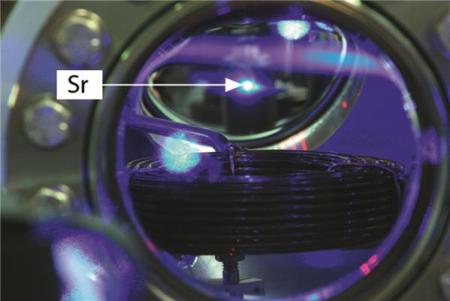Jan 3 2013
PTB measures the influence of the ambient temperature on strontium atoms for the first time – measurement uncertainty reduced by one order of magnitude
 View of the ultra-high vacuum chamber where strontium atoms are cooled and stored. The blue fluorescent light in the upper third of the window is a cloud of cold strontium atoms (the drop-shaped formation below the blue fluorescent atom beam in the upper part of the vacuum window). (Photo: PTB)
View of the ultra-high vacuum chamber where strontium atoms are cooled and stored. The blue fluorescent light in the upper third of the window is a cloud of cold strontium atoms (the drop-shaped formation below the blue fluorescent atom beam in the upper part of the vacuum window). (Photo: PTB)
An optical clock with neutral strontium atoms is considered one of the top candidates for the definition of a "new" second. The probabilities have increased considerably, since its frequency will now be determined more accurately (probably by an order of magnitude). Scientists of the Physikalisch-Technische Bundesanstalt (PTB) have laid the foundation for this by measuring, for the first time, the influence of the most important uncertainty factor, namely the ambient temperature. To date, its influence could only be derived theoretically. Their results, which have been published in the latest issue of the scientific journal Physical Review Letters, might well spark interest also in geodesy and in fundamental physical research – more specifically: in the question as to whether fundamental constants are really constant.
Optical clocks are deemed the clocks of the future. This has several reasons: they could allow the SI base unit the second (which is already the most accurate of all SI base units anyway) to be realized even more accurately. Its definition would then no longer be based on the interaction of microwave radiation with caesium atoms, but on the interaction of optical radiation with strontium (or other) atoms or ions. But even before the new definition, optical clocks are useful, e.g., in geodesy where they can help determine the Earth's geoid (basically, the exact position of "sea level") even more accurately than before. Furthermore, they provide fundamental physicists with the long-awaited instrument to perhaps detect possible changes in the fundamental constants, e.g. the fine-structure constant.
The reason why optical clocks are so accurate is that optical radiation oscillates extremely fast – considerably faster than microwave radiation, which is currently used in caesium atomic clocks to "produce" the second. The faster the "pendulum" (the oscillating system) of a clock, the finer the time can, in principle, be broken down and, thus, the more stable and accurate the clock becomes. In an optical strontium clock, a cloud of neutral strontium atoms is cooled down in two steps by means of laser radiation until the atoms finally exhibit a speed of only a few centimetres per second. A so-called "optical lattice" ensures that the atoms are trapped and can virtually no longer move. Unfortunately, strontium atoms, of all things, react relatively strongly to changes in the ambient temperature; their atomic levels are then shifted energetically, which causes the clock to become inaccurate. This is the highest contribution to the uncertainty of this clock, and PTB scientists have now succeeded in measuring it for the first time. To this end, they, however, needed an auxiliary system: in order to carry out measurements with the required accuracy, they considerably amplified the effect by using a static electric field instead of the alternating electromagnetic field of blackbody radiation. They constructed a special parallel-plate capacitor whose electric field is known with a few-ten-ppm accuracy. For this purpose, the distance between the two plates, which amounted to 0.5 cm, may only vary by a few 100 nm over its length of 7 cm; the same applies to the accuracy of the distance.
With this parallel-plate capacitor, the PTB scientists measured the influence of electromagnetic fields on the two decisive (for their clock) eigenstates in the strontium atom. In this way, they determined its uncertainty contribution to the total measurement uncertainty to 5 × 10-18. And because just this influence had, to date, been the most restrictive influence on the total measurement uncertainty, one can expect the next frequency measurements of the clock as a whole to lie well below the previously attained 1 × 10-16.